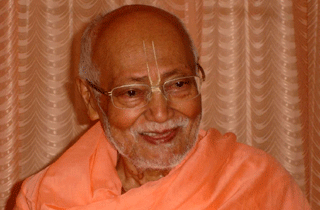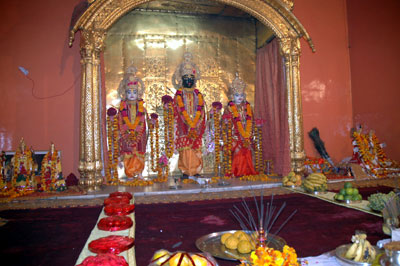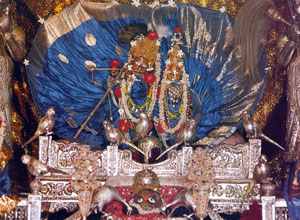 |
 |
|
 |
|
| |
|
|
Pilgrimage |
|
|
| |
|
|
Tirtha means a spiritual destination. Guru means a guide. Tirthaguru will take you on a tour of top pilgrimages (Tirthas) of the Indian sub-continent – Bharatvarsha, Hindustan, India! Tirthaguru is a tourist guide for the visiting pilgrims.
Tirtha - In Sanskrit the place of pilgrimage is called ‘Tirtha’. The word ‘Tirtha’ means, a spiritual destination or a sacred spot. This may be a holy river, mountain, or other place made sacred through association with a deity or saint.
The expression ‘Tirtha-Yatra’ literally means “undertaking journey to river fords”. A visit to sacred places is considered ‘tirtha yatra’. According to Hindu tradition, a visit to a holy place is not only a physical act but it also implies mental and moral discipline. Pilgrimage to sacred places is accepted as a desirable practice to earn religious merit (Phala) within a life lived according to ‘dharma’. It is one of the ways towards self-realisation and bliss.
Pilgrimage to a sacred place is of no avail if a person does not lead a moral life. There are many references in Indian scriptures that suggest moral life as a precondition for deriving any benefit from sojourn to holy sanctuaries and bathing in sacred rivers. A journey to a sacred place provides opportunity for the householder to detach himself for sometime from the cares and worries of daily life and to devote that time to prayer, contemplation, and listening to the discourses of holy men.
On the origin and development of the practice of pilgrimage (Tirtha-yatra), several views have been expressed by the scholars on the subject. The earliest description of the practice of Hindu pilgrimage (Tirtha-yatra) in Indian literature is found in the ‘Aitareya Brahmana’ of the Rig Veda.
|
| |
|
|
Importance of visiting Holy Places |
|
|
| |
|
|
 |
 |
The Srimad Bhagavatam (7.14.30-33) states: “ The sacred lakes like Puskara and Places where saintly persons live, like Kurukshetra, Gaya, Prayaga, Pulahasrama, Naimisaranya, the banks of the Phalgu River, Setubandhu, Prabhasa, Dwarka, Varanasi, Mathura, Pampa, Bindu-sarovara, Badarikasrama, the places where the Nanda River flows, the places where Lord Ramacandra and mother Sita took shelter, such as Citrakuta, and also the hilly tracts of land known as Mahendra and Malaya - all of these are to be considered most pious and sacred. Similarly, places where Radha-Krishna Deities are worshiped must all be visited and worshiped by those who want to be spiritually advanced. One who intends to advance in spiritual life may visit all these places and perform ritualistic ceremonies to get results a thousands times better than the results of the same activities performed in any other place.”
In his purport to Shrimad Bhagavatam (4.8.42) Srila A. C. Bhaktivedanta Prabhupada states; “Places of pilgrimage yield a special advantage for a devotee in quickly advancing his spiritual life. Lord Krishna lives everywhere, but still it is very easy to approach Him in holy places of pilgrimage because these places are inhabited by great sages. Lord Shri Krishna says that He lives wherever His devotees are chanting the glories of His transcendental activities. There are many places of pilgrimage in India, and especially prominent are Badarikasrama, Dwarka, Rameswara and Jagannatha Puri. These sacred places are called the four dhamas. Dhama refers to a place where one can immediately contact the supreme Lord. To go to Badarikasrama one has to pass through Haridwar. Similarly, there are other holy places of pilgrimage, such as Prayaga (Allahabad) and Mathura, and the topmost of them all is Vrindavana. Unless one is very advanced in spiritual life, it is recommended that he live in such holy places and execute devotional service there.”
In the material world the Lord is situated in different arca-murtis (Deities) in the temples, just to decrease the material activities of the conditioned soul and increase his spiritual activities. Particularly in India there are many temples throughout the country. Devotees may take advantage of them and go see the Lord at Jagannatha Puri, Vrindavana, Prayaga, Mathura, Haridwar and Vishnu-Kanci (Kanchipuram). When the devotees travel to these places and see the Lord, they become very happy in devotional service.” (Cc.Madhya 20.219) “There are four dhamas, or kingdoms of GOd, which represent the planets of the spiritual sky, which consists of the brahmajyoti and the Vaikunthas. These are Badarikasrama, Rameswara, Jagannatha Puri, and Dwarka. Faithful Hindus visit these holy places for perfection of spiritual realization.” (Purport to Shrimad Bhagavatam 3.4.22)
|
| |
|
|
| Major Sacred Pilgrimages or Tirthas of India |
|
|
| |
|
|
 |
 |
The major sacred pilgrimages or tirthas of India are: Char-Dhams - Badrinath, Dwarka, Puri and Rameshwaram; ‘Saptapuris’ i.e. seven sacred cities - Mathura, Ayodhya, Mayapuri (Haridwar), Kashi (Varanasi), Kanchi (Kanchipuram), Avantipuri (Ujjain) and Dwarka; four places of Kumbha Mela - Prayag Haridwar, Ujjain and Nasik; the seven most sacred rivers are - Ganga, Yamuna, Godavari, Saraswati, Narmada, Sindhu and Kaveri; the eight self-manifested holy places (Swayam Vyakta Khshetras) are - Sri Rangam, Triumala, Sri Mushnam and Thotadri in South India; and Shalagram, Pushkara, Naimisharanya and Badrinath in North India; twelve Jyotirlingas - Shri Som Nath in Sourashtra, Gujarat, Shri Mallikarjun in the Kurnool district, Andhra Pradesh, Shri Mahakaleshwar in Ujjain (M.P.),Shri Omkareshwar in Malwa (M.P.), Shri Kedar Nath in the Himalayas (U.P.),Shri Vishweshwar (Vishwanath) in Varanasi (U.P.),Shri Trimbakeshwar, near Nasik in Maharashtra, Shri Baidyanath in Bihar,Shri Nageshwar in Gujarat, Shri Rameshwar, Tamil Nadu, Shri Ghrishneshwar in Swalaya near the Ellora Caves, Maharashtra and fifty one ‘Shakti-Peethas’. Seven Parvat: Himalaya, Arawali, Vindhyachal, Mahendra, Malaya, Sahyadri and Raivatak
|
| |
|
|
| Top spiritual destinations in India |
|
|
| |
|
|
- Char Dhams (Four Abodes of God )
- Char Kumbhas (Four places of Kumbha fair)
- Sapta Moksha Puris (Seven holy cities)
- Dwadash Jyotir Linga (12 abodes of Shiva)
- Seven Holy Rivers (Ganga, Yamuna, Godavari, Saraswati, Narmada, Sindhu & Kaveri)
- Seven Holy Parvats (mountains)
- Five Sacred Lakes
- Fifty One Shakti Peethas
- 108 Self-manifested Kshetras
- Three sacred seas
- Most popular destinations (Tirupati, Shri Nath ji, Vaishno Devi, Navadwipadham)
- Other Tirthas: Amarnath, Gaya, Kurukshetra, Pandharpur, Sri Rangam, Madurai. Tanjore, Srigeri, Chidambram
|
|
 |
|